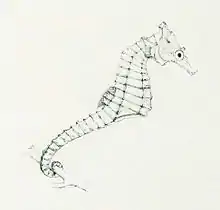Giraffe seahorse
The giraffe seahorse (Hippocampus camelopardalis) is a species of fish of the family Syngnathidae.[4] It is found in coastal waters off of the south and east coasts of Africa, from South Africa to Tanzania, and possibly north to Kenya.[1] It lives in estuarine seagrass beds, algae beds, and shallow reefs to depths of 45 metres (148 ft), where it can grow to lengths of 10 centimetres (3.9 in).[1][5] It is expected to feed on small crustaceans, similar to other seahorses. This species is ovoviviparous, with males carrying eggs in a brood pouch before giving birth to live young. Individuals are sexually mature at around 6.5 centimetres (2.6 in).[5] Major threats to this species could be habitat loss, through coastal development and pollution, and overexploitation through bycatch.[1] Some other threats include human use by drying out the seahorse for traditional medicine or as a curio.
| Giraffe seahorse | |
|---|---|
 | |
| Scientific classification | |
| Domain: | Eukaryota |
| Kingdom: | Animalia |
| Phylum: | Chordata |
| Class: | Actinopterygii |
| Order: | Syngnathiformes |
| Family: | Syngnathidae |
| Genus: | Hippocampus |
| Species: | H. camelopardalis |
| Binomial name | |
| Hippocampus camelopardalis Bianconi, 1854 | |
| Synonyms[3] | |
| |
Some distinctive characteristics include dark spots, one on the top of the coronet or crown of the seahorse's head and some on the dorso-lateral surface of the seahorse. It has a prominent spine above its eye in both the female and male specimen.
References
- Pollom, R. (2017). "Hippocampus camelopardalis". IUCN Red List of Threatened Species. 2017: e.T10064A100939136. doi:10.2305/IUCN.UK.2017-3.RLTS.T10064A100939136.en. Retrieved 17 November 2021.
- "Appendices | CITES". cites.org. Retrieved 2022-01-14.
- Froese, Rainer; Pauly, Daniel (eds.) (2018). "Hippocampus camelopardis" in FishBase. February 2018 version.
- Scales, Helen (2009). Poseidon's Steed: The Story of Seahorses, From Myth to Reality. Penguin Publishing Group. p. 136. ISBN 978-1-101-13376-7. Retrieved 9 June 2019.
- Lourie, S.A., A.C.J. Vincent and H.J. Hall, 1999. Seahorses: an identification guide to the world's species and their conservation. Project Seahorse, London. p.214
Further reading
- iNaturalist
- Encyclopedia of Life
- WoRMS
- iSeahorse
- IUCN Seahorse, Pipefish & Stickleback Specialist Group
